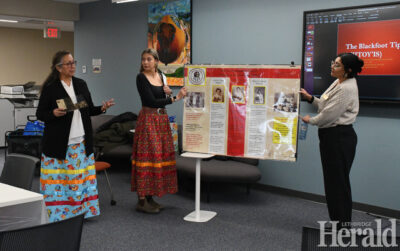Nursing students get crash course on Indigenous health
By Theodora MacLeod - Lethbridge Herald Local Journalism Initiative Reporter on November 25, 2023.
 Herald photo by Theodora MacLeod
Lori Healy, director of Community Health Services with the Blood Tribe, along with nursing student, Trista Shade, and Santanita Oka, Indigenous mental health outreach worker, highlight influential Blood Tribe nurses in southern Alberta history.
Herald photo by Theodora MacLeod
Lori Healy, director of Community Health Services with the Blood Tribe, along with nursing student, Trista Shade, and Santanita Oka, Indigenous mental health outreach worker, highlight influential Blood Tribe nurses in southern Alberta history.Nursing students at the University of Lethbridge were given a crash course in Indigenous health and history on Thursday thanks to the Nursing Students’ Association and the Indigenous Mental Health Outreach program.
Gathering in the Iikaisskini Centre, students and community members heard from Director of Community Health Services with the Blood Tribe Department of Health Lori Healy before diving into an art therapy practice that had participants decorate their own miniature tipis.
In her presentation, Healy gave a brief, but thorough, overview of various aspects of Blackfoot culture.
From spiritual teachings and a glimpse into the community prior to colonization, to the long-lasting impact residential schools and generational trauma have had on members of the Blood Tribe, the lesson provided nursing students – some who previously may have not been familiar with Blackfoot ways of knowing- with an insight into the local Indigenous community.
“Pre-contact, we practiced traditional medicine because we had to use what we had. Our people lived in a closed system… the closed system was our families, our extended families… they all lived together in a clan,” Healy explains. “We had traditional spiritual healers back then.” She adds that the people had a much stronger connection to dreams, their environment, and animals. “We all walked together.”
“Our medicine came from the traditional medicines that we pick now… mint, sage, sweetgrass… it was a combination of spirituality too,” Healy continues, before explaining that many diseases were introduced through residential schools.
“The close proximity of dormitories created the perfect area for pneumonia to set in, bronchitis, T.B. Our people were really affected by T.B.”
Illness, in addition to the abuses students faced while at the schools, have had a generational impact that Healy says impacts the health care system. “You’re going to see our people; they have alcohol and drug use-abuse issues. Children are affected by Fetal Alcohol Syndrome and Fetal Alcohol Effects. This is really challenging to the family, to our school system, to just generally the community. These are long term effects that we are currently fixing, and currently supporting.”
She says that as well as addictions, the disruption and trauma of residential schools left a lasting impression on family structure and relationships that the community still deals with.
“Parenting issues, this is the big one. The issues around emotional coldness, rigidity, neglect, poor communication, and abandonment. This is something that was taught in residential school.”
Healy also provided attendees with insights into some of the resources offered by the Blood Tribe to support struggling members of the community. Some of the indicatives include parenting programs, detox and substance abuse treatment facilities, a mobile medical unit, and mental health wellness programs.
Following Healy’s presentation, her granddaughter, nursing student Trista Shade, led the group in a cathartic and informative tipi-decorating craft where the group was given the opportunity to discuss what was learned and engage in therapeutic art practices while learning more about the Blackfoot culture at its essence.
Healy and Shade’s presentations demonstrated how disconnection from spirituality and culture, in combination with the multiple layers of unresolved grief and loss, have led to chronic physical and mental health concerns throughout Indigenous communities.
14-13


